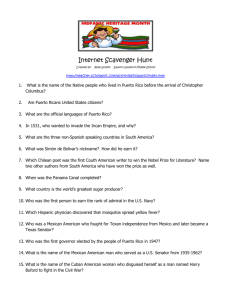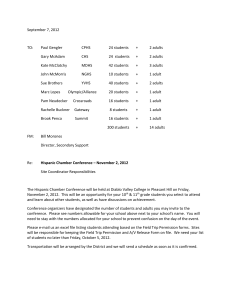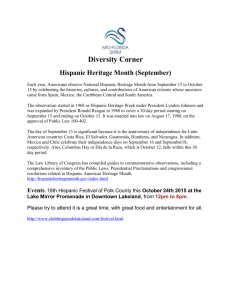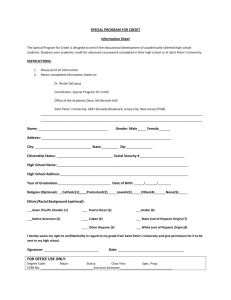Alcohol use and binge drinking among Hispanic/Latino subcultural
advertisement
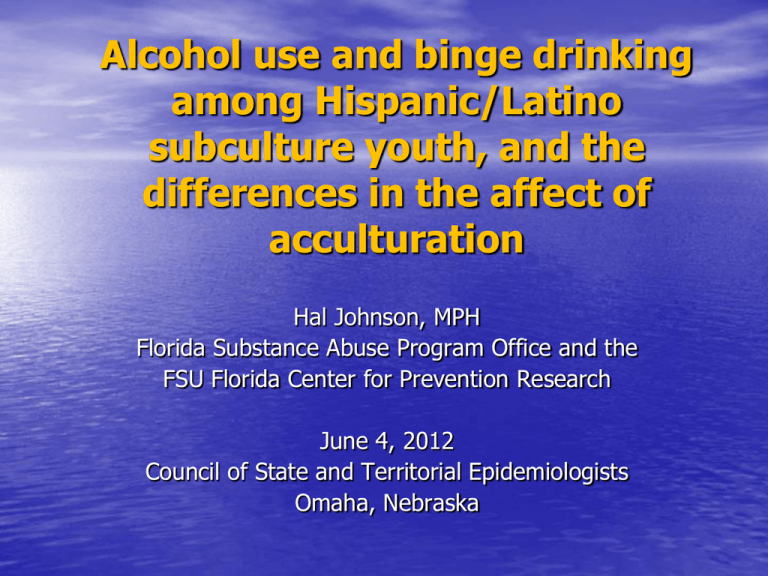
Alcohol use and binge drinking among Hispanic/Latino subculture youth, and the differences in the affect of acculturation Hal Johnson, MPH Florida Substance Abuse Program Office and the FSU Florida Center for Prevention Research June 4, 2012 Council of State and Territorial Epidemiologists Omaha, Nebraska Background • Risky behaviors vary among different races/ethnicities • Hispanic ethnicity is a growing portion of the US population • Many programs/interventions have been developed to reduce risky behaviors, including underage drinking, among Hispanic youth. Background • However, most of these programs don’t distinguish between Hispanic subcultures • Spanish, Mexican, Puerto Rican, Central American and other Hispanic cultures, while sharing some aspects, are different • Examining differences between these subcultures in the US is challenging for several reasons Background • Challenges – Immigration patterns - limited diversity of Hispanic subcultures in most areas – Underage drinking – limited age range means limited population – Few databases include information on ethnicity at a level lower than “Hispanic” Florida Youth Substance Abuse Survey • Annually since 2000 – Even years – County level (~60,000) – Odd years – State level (~8,000) • Grades 6 through 12 • Based on Communities That Care Survey Florida Youth Substance Abuse Survey How do you describe yourself? (You can choose one answer, or more than one) American Indian/Native American or Alaska Native Asian Black/African American Spanish/Hispanic/Latino Native Hawaiian or other Pacific Islander White/Caucasian Other Florida Youth Substance Abuse Survey Which one of these ethnic groups BEST describes you? (Choose only one answer) Central American (Guatemalan, Nicaraguan, Honduran, for example) Cuban or Cuban American Dominican Mexican or Mexican American Puerto Rican Other Hispanic, Latino or Spanish origin Haitian West Indian or Caribbean None of these Florida Youth Substance Abuse Survey • Consistent differences by race/ethnicity – Whites use at the highest rate – Black youth use at lowest rate – Hispanic youth use at a slightly lower rate than non-Hispanic Whites • Similar results from other school based surveys such as Monitoring the Future Florida Youth Substance Abuse Survey Florida Youth Substance Abuse Survey Binge Drinking by 6th - 12th graders in Florida, 2010 20.0% 16.6% 15.1% 9.7% 0.0% White Black Hispanic Hispanic Youth Population Trend * Source: Florida Office of Economic and Demographic Research (Age 10-17) Florida youth Ethnicity (FYSAS) Hispanic Subcultures among Florida youth (FYSAS) Data Considerations • Use even year data • Exclude 2000 – Changes made in race/ethnic variables • Compare each year for variations • Combine years • Weight to adjust for sample size Population Proportion Across Years Combined Dataset Ethnicities 2002 2004 2006 2008 2010 Combined HispanicHispanic Non-Hispanic Non-Hispanic Total N 10,467 2002 52,467 10,467 52,467 62,934 12,140 60,345 2004 48,205 12,684 56,352 2006 43,668 12,140 48,205 20,343 90,694 2008 70,351 16,563 72,797 2010 56,234 12,684 43,668 Combined 72,197 270,925 343,122 20,343 70,351 16,563 56,234 72,197 270,925 Total N 62,934 60,345 56,352 90,694 72,797 343,122 Past-30-day Alcohol Use Binge Drinking Odds Ratios Past-30-day alcohol use OR Central American .792 Cuban .919 Dominican .825 Mexican .865 Puerto Rican .871 Other Hispanic 1.039 99% C.I. Lower Upper .749 .838 .877 .962 .758 .897 .817 .917 .832 .912 .995 1.086 Binge Drinking 99% C.I. Lower Upper .742 .857 .782 .879 .768 .948 .952 1.095 .791 .889 .929 1.036 * p < .001 Central American Cuban Dominican Mexican Puerto Rican Other Hispanic OR .797 .829 .854 1.021 .838 .981 * * * * * * * * * Reference Group: Non-Hispanic White Control Variables: Age Gender Mother’s education Father’s education Acculturation Coatsworth and Maldonado-Molina. J Community Psychol. 2005. 33(2). Acculturation • Acculturation has been implicated as a risk factor for substance use and other unhealthy behaviors • 1990 to 2000 Hispanic Population Growth* – 50% increase in # American-born Hispanics – 81% increase in # born in other countries • In 2000, 40% of all Hispanics and 54% of southern US Hispanics were foreign born* *Saenz, R. www2.asanet.org/public/saenz_brief.ppt Acculturation • Length of time in the US related to less acculturation • Language spoken at home is reasonable proxy for length of time in US and acculturation • FYSAS has one question on language spoken at home Acculturation FYSAS question: What is the language you use most often at home? English Spanish Another Language Language Spoken at Home Central American Cuban Dominican Mexican Puerto Rican Other Hispanic ALL HISPANIC Frequency English Spanish 10830 2254 5807 3402 2078 1333 6946 7966 10807 4720 6446 5894 42914 25569 Percent English Spanish 82.8 17.2 63.1 36.9 60.9 39.1 46.6 53.4 69.6 30.4 52.2 47.8 62.7 37.3 Past-30-day Use and Binge Drinking by Language Spoken at Home – All Hispanic Youth Odds Ratios – Language Spoken at Home ALL HISPANIC YOUTH Past-30-day Alcohol Binge Drinking 99% C.I. OR Lower Upper .917 .881 .956 * .975 .926 1.026 *p<.001 OR Group: Speak Spanish at Home Reference Group: Speak English at Home Control Variables: Age Gender Mother’s education Father’s education Past-30-Day Alcohol Use by Language Spoken at Home Binge Drinking by Language Spoken at Home Odds Ratios – Language Spoken at Home Past-30-day alcohol use OR Central American .934 Cuban .855 Dominican 1.016 Mexican .760 Puerto Rican .898 Other Hispanic .948 Binge Drinking Central American Cuban Dominican Mexican Puerto Rican Other Hispanic OR .791 .942 .976 .869 1.001 1.039 99% C.I. Lower Upper .833 1.047 .783 .933 .859 1.203 .680 .851 .816 .988 .871 1.032 OR Group: Speak Spanish at Home * * ** 99% C.I. Lower Upper .681 .919 * .841 1.055 .789 1.207 .759 .995 ** .886 1.130 .934 1.155 *p<.001 **P<.01 Reference Group: Speak English at Home Control Variables: Age Gender Mother’s education Father’s education Summary • All Hispanic youth in Florida drink and binge • drink at a rate between NH-Whites and NHBlacks But there are differences among the Hispanic subcultures – Central American youth less likely to drink or binge than others – “Other Hispanic” youth more likely to drink or binge than others – Mexican youth more likely to binge than others Summary • Hispanics speaking Spanish at home less likely to report past-30-day use, but not binge drinking • Subculture differences: – Cuban, Mexican and Puerto Rican youth show past-30-day acculturation affect – Central American and Mexican youth show binge drinking acculturation affect – No other significant differences Conclusions • FYSAS provides an excellent opportunity to investigate AOD use and other risky behavior among Hispanic subpopulations – Large and growing Hispanic youth population – More diverse Hispanic population than most states – Annual youth survey with large N and useful ethnicity and acculturation questions Conclusions • Hispanic youth are not homogeneous – There are differences in alcohol use and binge drinking among subcultures – There are differences in the affect of acculturation on likelihood to drink or binge drink • Taking subculture into account can add to the effectiveness of targeted prevention programs

